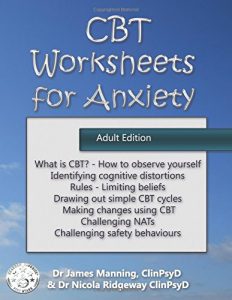★★★★
“CBT,” short for “cognitive-behavioral therapy,” is a type of psychological therapy designed to alleviate anxiety, depression, and related or co-morbid disorders and issues. It is an action-oriented approach that asks those undertaking it to work towards goals and actively “reprogram” themselves away from bad habits and into healthier mind-frames. It is currently considered one of the most effective approaches in psychotherapy and is often stated to be the most visibly effective of these in popular psychotherapy.
Despite its name, CBT Worksheets for Anxiety is much more than just a stack of worksheets for a patient to work through. It has all the basic resources to understand this discipline, including explanations of the typical symptoms, causes, mechanics, and therapeutic methods for anxiety, as well as all the tried-and-tested charts, mood diaries, and mind diagrams that help a reader self-diagnose (to a degree) and review their symptoms. As much as the word “symptoms” is quite big and scary, the book makes a point that many of the “symptoms” are simply normal responses and nothing unusual, just that any over-abundance of these symptoms can be difficult to live with. It’s not a touchy-feely book; this guide is straight-forward and direct in its addressing of problems and simply gives clear facts and advice.
The book has a simple, sleek design that marks it as an academic and psychological resource, including a reasonably dyslexia-friendly font for its title – a nice touch on the otherwise text-heavy cover. The text inside is well-organized and logically sequential, making it easy to locate specific information very quickly. Some diagrams, especially tables, are a little misaligned and when set next to a page with one of the few images sized incorrectly it can give a bad impression. It’s not a big deal, however, and the text is thankfully low on copy-editing errors.
It’s worth noting that it can be inherently difficult to “self-help” through CBT due to the confrontational nature of the therapy, which is best facilitated by another actual human being who’s able to react personally to the individual’s responses. In many ways, a book is not a complete substitute for a trained professional in the practice. The book itself states “this book does not attempt to replace any other instructions from your doctor or qualified practitioner.” That said, this book has been written by renowned professionals in the field; both Dr. James Manning and Dr. Nicola Ridgeway are doctorates of Clinical Psychology, actively working as therapists at the West Suffolk CBT Service in England.
Doctors Manning and Ridgeway have done well in producing their book. It’s a fairly standard piece of literature on the subject with everything one might expect, perfect for anyone entering into a course of CBT or who has just begun to study the practice. It’s well-laid out, clear, concise, and understandable, which makes it the perfect resource on the topic for therapists, sufferers, and even just readers interested in self-help techniques.
Review Overview
Design
Content
Editing
Get an Editorial Review | Get Amazon Sales & Reviews | Get Edited | Get Beta Readers | Enter the SPR Book Awards | Other Marketing Services
























Leave A Comment